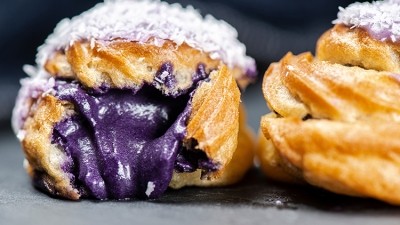Promotional Features
From Matcha to Sriracha: Asian Flavor Trends from the World’s Leading Expert in Eastern Food & Beverage Flavors
It’s official – Asian food is the fastest growing cuisine in the United States.
According to a Euromonitor report, sales of Asian QSR food grew by more than 135% over the last 25 years and the category has a CAGR of 11.8% forecasted through 2026. The rise of Asian foods is reflective of a larger overall trend toward international cuisine, spurred by increasingly adventurous tastes of younger consumers and broadening demand for exciting new food experiences during the COVID-19 pandemic.
While grouped together, the Asian food and beverage category represents a diversity of cuisines ranging from Chinese and Japanese to Korean, Thai, Indonesian, Indian, Vietnamese and many more. The consistent aspect between these vastly different foods is a long tradition of rich flavors, exotic ingredients and innovative cooking techniques.
For nearly 120 years, Asian food and beverage flavors and aromas have been the backbone for T. Hasegawa. With its origins in Japan starting in 1903, T. Hasegawa Co., Ltd. has grown to become one of the world’s top ten flavor and fragrance companies, and specifically the world’s leading expert on Asian flavors. The company’s California-based subsidiary, T. Hasegawa USA, produces flavors for some of the world’s top brands, with innovative technologies and processes designed to maximize the flavor of Asian foods and beverages.
As part of T. Hasegawa’s leadership and expertise in flavors, the company remains at the forefront of emerging consumer food and beverage trends, tracking what consumers are looking for in packaged foods, beverages and restaurant menus. With nearly 120 years of expertise in Asian food and beverage flavors, T. Hasegawa is uniquely positioned to highlight some of the latest trends on this ever-growing category:
From the Menu to the Market – the Role of Restaurants
Many U.S. consumers are first introduced to Asian cuisines via restaurant menus. There is a long history of Chinese food in the United States dating back to the 1848 California Gold Rush, and subsequent waves of immigration from Japan, Korea, Vietnam, the Philippines and other Asian countries have turned dishes like ramen, sushi, kimchi, pho and adobo into household staples for millions of Americans. These classic dishes may have origins in home kitchens, but they first became famous as menu items in restaurants that began opening across the country in the late 20th century, introducing U.S. consumers to the unique flavors of Asian foods.
With a long history of restaurants playing a crucial role in the introduction of Asian food and beverage flavors to U.S. consumers, brands should pay close attention to the ingredients and flavors that are emerging on menus today. Ingredients like soy sauce, sesame seed and sriracha are already standard in kitchens across North America, so these flavors can be combined with lesser-known flavors like miso, Thai curry and lemongrass in the development of new food products that will be successful with U.S. consumers.
“Here in Southern California, we have some of the largest Asian-American communities in the U.S. and certainly the most diverse, with a growing population of immigrants from Korea, China, Japan, Vietnam, Indonesia, India and other Asian countries,” said Doug Resh, director of commercial marketing at T. Hasegawa USA. “The remarkable restaurants in these communities continue to serve as not only inspiration for T. Hasegawa’s development of new flavors, but also ensure that the flavor profiles our team is creating are authentic.”
High Heat = Full Flavor
Many Asian cuisines are notoriously spicy – and consumers apparently can’t get enough. In fact, the total market for hot sauce in North America is currently over $1.13 Billion with a CAGR of 7.1% through 2028. The U.S. and Canada account for more than 40% of the global chili hot sauce market, showing impressive demand and future growth of this category. As consumer tastes shift toward increasingly hotter menu items, brands are seeking creative ingredients and flavors sourced from Asian cuisine to deliver on the demand for fiery foods.
Certain regional chili-based Asian flavors such as Sichuan, mala and sriracha have untapped potential for unique new flavor profiles that deliver on consumer demand for heat. The chili-based flavors have a pronounced garlicky umami profile that pairs well with savory flavors such as Thai curry, Japanese teriyaki and Korean barbecue.
“In recent years, our team has explored the possibilities of mala seasoning as a high-heat flavor in a wide variety of foods,” said Takahiro Nakazato, senior flavor chemist at T. Hasegawa USA. “Mala is a Sichuan peppercorn and chili seasoning traditionally used in hotpot restaurants and delivers a specific spicy numbness taste. It’s up-and-coming as a seasoning in potato chips and other snack foods, transitioning from restaurants to supermarket shelves.”
Discovering the Potential of Fusion Flavors
Another Asian cuisine trend that continues to grow each year is fusion foods. A uniquely American creation, fusion foods blend the familiarity of multiple international flavors into a unique new dish. Nowhere is this trend more evident than in Southern California’s food truck culture, which expanded from the region’s diverse population and produced foods like bulgogi tacos. This unique food truck menu item fuses a classic Mexican dish with sweet and spicy Korean beef, topped with creamy gochujang chili sauce.
“Fusion foods are really expanding the possibilities of Asian flavors and creating foods that are uniquely American while having a broad appeal to consumers,” explained Resh. “The key to a successful fusion product is the bold authentic taste of Asian flavors and spices, which are typically savory protein marinades and sauces such as sriracha and gochujang. Our team has developed countless sauce and condiment flavors that fit perfectly with the growing trend of fusion foods.”
Gochujang, a red chili-based fermented sauce that offers a sweet and spicy kick to savory foods, is poised to become the ‘next sriracha,’ as it grows increasingly popular and expanding from Korean restaurants and food trucks to mainstream supermarkets across the U.S. The market for gochujang was primed by the meteoric rise of sriracha chili sauce over the last decade emerging from a specialty tableside condiment at U.S. Thai and Vietnamese restaurants to a pop culture phenomenon enjoyed by millions of people around the world.
Asian Cuisine Delivers a ‘Health Halo’
One of the greatest strengths of Asian cuisine is the implied ‘health halo’ that these foods deliver. More than 60% of participants in a recent Mintel survey stated they associate Asian cuisine with offering a good variety of flavors and 42% associated Asian foods with being healthy. These consumer perceptions indicate a major market opportunity for brands who can tap into the rich flavors of Asian cuisine while also fitting into trending plant-based or flexitarian diets that are currently popular among younger consumers.
“Asian cuisine is strongly associated with fermented flavors, which are typically perceived as healthy,” explained Nakazato. “Ingredients like Korean kimchi and doenjang, Japanese miso, Indonesian tempeh and even kombucha are growing increasingly popular since they deliver a strong flavor profile with implied health benefits.”
More than 39% of consumers in the Mintel study cited they would like to eat more Asian ingredients that are healthy, indicating further opportunity for future growth in this category.
Satiating an Appetite for Adventure
“A recurring theme over the past couple years is consumers turning to complex food flavors as a source of excitement and adventure during the pandemic,” explained Resh. “Asian cuisine’s broad range of exotic ingredients, complex flavor profiles and often spicy sauces and seasonings deliver precisely the culinary escape that consumers are looking for right now. One emerging trend from this period is the growth of increasingly elaborate ramen flavors, which offer a balance of familiarity and comfort while also allowing for experimentation and bold flavors – a recipe to stave off pandemic-induced boredom for U.S. consumers looking to spice up their lunch while working from home.”
The pandemic also shifted cooking habits for millions of Americans, decreasing reliance on foodservice and prompting many consumers to seek out compelling new sauces, marinades and spices to help create great-tasting meals in the kitchen. According to a Mintel survey, 25% of consumers say they are more comfortable cooking Asian cuisine than they were prior to the pandemic. Often this newfound confidence in the kitchen was found in flavorful ingredients that made it easier to replicate favorite Asian meals and flavor profiles, such as Thai curry, miso, ponzu and hoisin sauces. Many consumers even experimented with at-home fusion, adding chili-based sauces like sambal, gochujang, sriracha and chili crisp to provide a distinctly Asian profile to other types of dishes.
The Future of Asian Flavors in the U.S.
As the North American population grows and diversifies, consumer food trends will continue to evolve as well. While the Asian-American community is still a smaller segment of the overall U.S. population, it’s growing quickly. U.S. Census data predicts a 23.8% increase in the Asian-American population from 2016 through 2026, and as this population grows, interest in Asian cuisine will expand with lesser-known ingredients and regional flavors rising to prominence.
Manufacturers can anticipate considerable category growth in coming years and leverage consumers’ interest in the rich, savory taste of Asian cuisine, adventurous approach to experimenting with these flavors and perceived health halo of these foods.
Food and beverage brands who are looking to take their asian food and beverage products to the next level of flavor can explore the possibilities by contacting T. Hasegawa USA at www.thasegawa.com or by calling (866) 965-0502.







